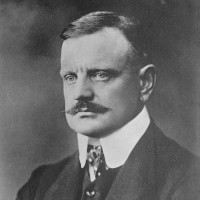

Jean Sibelius
Two Pieces, Op. 111
Short instrumentation: 2 2 2 2 - 4 2 3 1, timp, str
Duration: 12'
Bearbeitung: Luukas Hiltunen
Instrumentation details:
1st flute
2nd flute
1st oboe
2nd oboe
1st clarinet
2nd clarinet
1st bassoon
2nd bassoon
1st horn in F
2nd horn in F
3rd horn in F
4th horn in F
1st trumpet in Bb
2nd trumpet in Bb
1st trombone
2nd trombone
3rd trombone
tuba
timpani
violin I (12 players)
violin II (10 players)
viola (8 players)
violoncello (6 players)
double bass (4 players)
Two Pieces, Op. 111
Sample pages
Work introduction
The present publication of our composer Mr. Luukas Hiltunen's transcriptions for symphony orchestra of his native-land's most well-known composer Jean Sibelius's (1865–1957) Two Pieces, Op. 111, for organ, marks a significant event in the Universal Edition's history. We are proud to present these diligently prepared adaptations for the world!
The first of the pieces, Intrada Op. 111a, was composed in 1925 to accompany the visit of the King and Queen of Sweden and was first performed on August the 22nd 1925 in Helsinki Cathedral, performed by organist John Sundberg (1875–1938). It is one of the grandest works in the Finnish organ music repertoire, and its orchestral character made it ideal to be arranged for symphony orchestra. Mr. Hiltunen's orchestral setting was premiered by the Lahti Symphony Orchestra and conductor Dima Slobodeniouk on September the 8th, 2018 at the closing concert of the Sibelius Festival in Lahti Sibelius Hall, and during the reworking for the publication the instrumentation was augmented with a timpani at the behest of the Sibelius Family.
Mournful Music, Op. 111b, was composed in just a few days in 1931 for the funeral of Sibelius's friend and musical champion Akseli Gallen-Kallela (1865–1931). It is also Sibelius's very last instrumental composition. Mournful Music is an exciting work in its archaic nature, unlike any other work by Sibelius. After Sibelius’ passing, the composer's wife Aino Sibelius (1871–1969) revealed to composer Joonas Kokkonen (1921–1996) that the Mourful Music would contain musical material from the Eighth Symphony, an enigmatic work that has attained an even mysterious status, whose sketches Sibelius burnt in the fireplace at Ainola in 1945, thus destroying the work. So when the work is performed by a symphony orchestra, it is possible to get an auditory approximation of what the Eighth Symphony might have been like, even slightly. The orchestration underwent some minor adjustments in August 2022.

